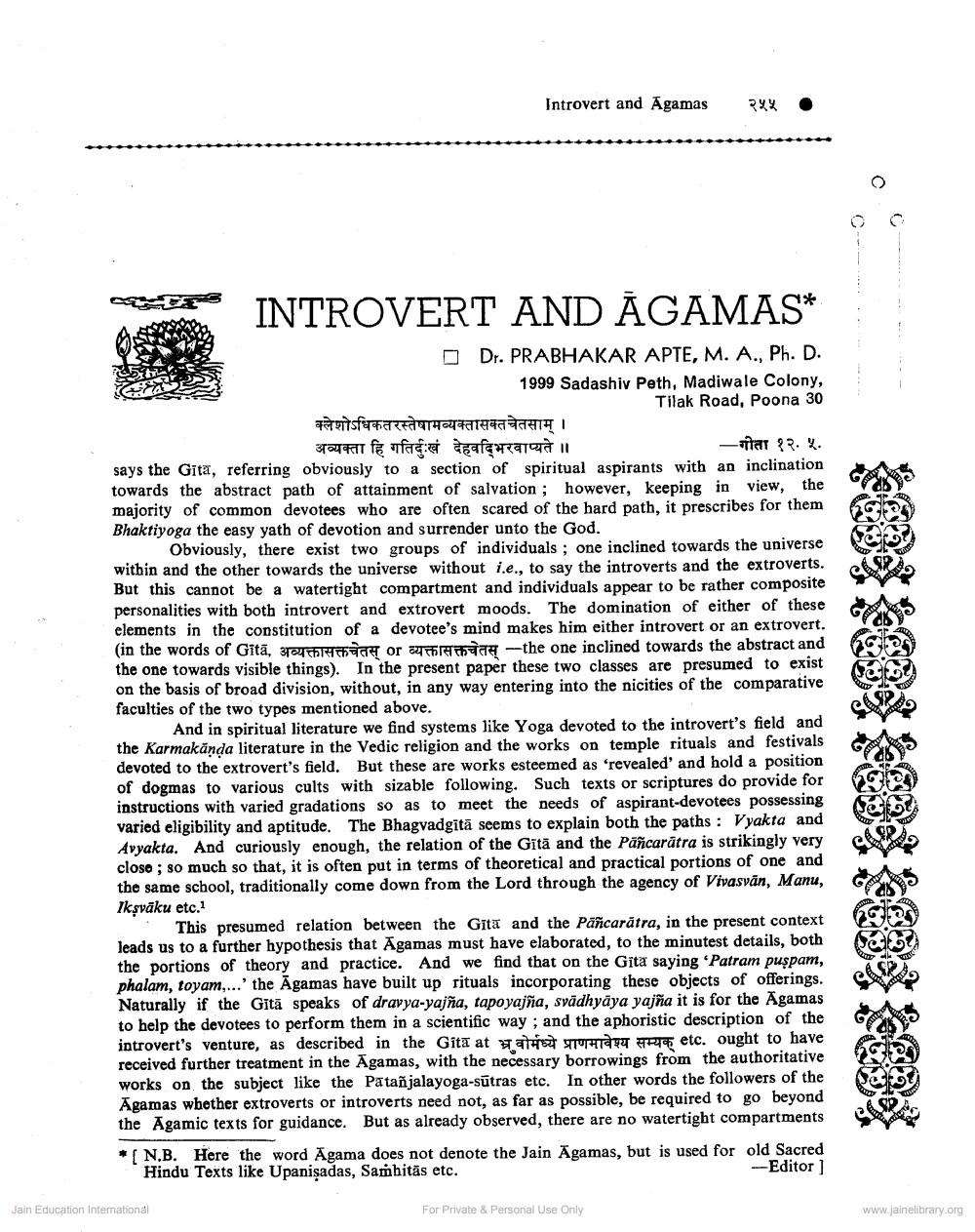Book Title: Introvert and Agamas Author(s): Prabhakar Apte Publisher: Z_Pushkarmuni_Abhinandan_Granth_012012.pdf View full book textPage 1
________________ Introvert and Agamas २५५ INTROVERT AND AGAMAS Dr. PRABHAKAR APTE, M. A., Ph. D. 1999 Sadashiv Peth, Madiwale Colony, Tilak Road, Poona 30 क्लेशोऽधिकतरस्तेषामव्यक्तासक्तचेतसाम् । अव्यक्ता हि गतिदुःखं देहवदिभरवाप्यते ॥ - गीता १२.५. says the Gita, referring obviously to a section of spiritual aspirants with an inclination towards the abstract path of attainment of salvation; however, keeping in view, the majority of common devotees who are often scared of the hard path, it prescribes for them Bhaktiyoga the easy yath of devotion and surrender unto the God. Obviously, there exist two groups of individuals; one inclined towards the universe within and the other towards the universe without i.e., to say the introverts and the extroverts. But this cannot be a watertight compartment and individuals appear to be rather composite personalities with both introvert and extrovert moods. The domination of either of these elements in the constitution of a devotee's mind makes him either introvert or an extrovert. (in the words of Gītā, अव्यक्तासक्तचेतस् or व्यक्तासक्तचेतस् - the one inclined towards the abstract and the one towards visible things). In the present paper these two classes are presumed to exist on the basis of broad division, without, in any way entering into the nicities of the comparative faculties of the two types mentioned above. And in spiritual literature we find systems like Yoga devoted to the introvert's field and the Karmakaṇḍa literature in the Vedic religion and the works on temple rituals and festivals devoted to the extrovert's field. But these are works esteemed as 'revealed' and hold a position of dogmas to various cults with sizable following. Such texts or scriptures do provide for instructions with varied gradations so as to meet the needs of aspirant-devotees possessing varied eligibility and aptitude. The Bhagvadgītā seems to explain both the paths: Vyakta and Avyakta. And curiously enough, the relation of the Gita and the Pañcaratra is strikingly very close; so much so that, it is often put in terms of theoretical and practical portions of one and the same school, traditionally come down from the Lord through the agency of Vivasván, Manu, Ikṣvāku etc.1 Jain Education International This presumed relation between the Gita and the Pañcaratra, in the present context leads us to a further hypothesis that Agamas must have elaborated, to the minutest details, both the portions of theory and practice. And we find that on the Gita saying 'Patram puspam, phalam, toyam,...' the Agamas have built up rituals incorporating these objects of offerings. Naturally if the Gita speaks of dravya-yajña, tapoyajña, svädhyāya yajña it is for the Agamas to help the devotees to perform them in a scientific way; and the aphoristic description of the introvert's venture, as described in the Gita at etc. ought to have received further treatment in the Agamas, with the necessary borrowings from the authoritative works on the subject like the Patañjalayoga-sutras etc. In other words the followers of the Agamas whether extroverts or introverts need not, as far as possible, be required to go beyond the Agamic texts for guidance. But as already observed, there are no watertight compartments [N.B. Here the word Agama does not denote the Jain Agamas, but is used for Hindu Texts like Upanisadas, Samhitās etc. For Private & Personal Use Only old Sacred -Editor ] www.jainelibrary.orgPage Navigation
1 2 3
